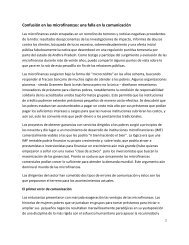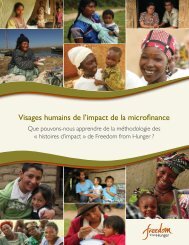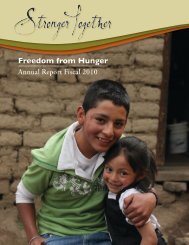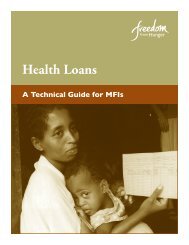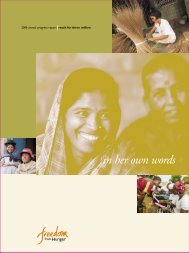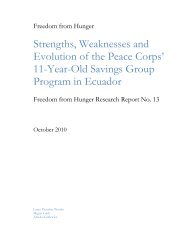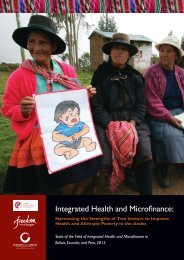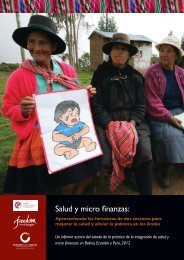history of meals for millions, soy, and freedom from ... - SoyInfo Center
history of meals for millions, soy, and freedom from ... - SoyInfo Center
history of meals for millions, soy, and freedom from ... - SoyInfo Center
You also want an ePaper? Increase the reach of your titles
YUMPU automatically turns print PDFs into web optimized ePapers that Google loves.
• Summary: Dr. Henry Borsook, pr<strong>of</strong>essor <strong>of</strong> biochemistry<br />
at Cali<strong>for</strong>nia Institute <strong>of</strong> Technology, famous <strong>for</strong> his work<br />
with American <strong>soy</strong>beans, was awarded this Certificate <strong>of</strong><br />
Recognition in September at the meeting <strong>of</strong> the Southern<br />
Cali<strong>for</strong>nia Institute <strong>of</strong> Food Technologists.<br />
The citation was given <strong>for</strong> his 14 years <strong>of</strong> work in the<br />
development <strong>and</strong> promotion <strong>of</strong> Multi-Purpose Food (MPF)<br />
as research director <strong>of</strong> the nonpr<strong>of</strong>it Meals <strong>for</strong> Millions<br />
Foundation–whose goal is to conquer world hunger.<br />
In 1944 Clif<strong>for</strong>d Clinton, Los Angeles restaurateur,<br />
asked Dr. Borsook to develop a food high in nutrition, low<br />
in cost, compact, stable in all climates, easy to cook, <strong>and</strong><br />
in<strong>of</strong>fensive to religious principles <strong>of</strong> any people. The result<br />
was MPF, based on defatted <strong>soy</strong>bean meal [sic, grits].<br />
126. Chamberlain, Ernest R. 1958. Re: U.S. government<br />
should encourage food use <strong>of</strong> high-protein, low-cost oilseed<br />
<strong>meals</strong>. Letter to U.S. Senator Mike Mansfield, Washington,<br />
DC, Dec. 18. 2 p.<br />
• Summary: “... envision the secondary consequences <strong>of</strong> a<br />
U.S. governmental policy that would focus world attention<br />
on the acceptability <strong>and</strong> value <strong>of</strong> oil-seed <strong>meals</strong> as highprotein,<br />
low-cost Human Food.<br />
“Without reliance on a support price American <strong>soy</strong>bean<br />
farmers have increased their <strong>soy</strong>bean crop 100-fold in 30<br />
years without producing a surplus–providing vegetable oil<br />
<strong>for</strong> margarine <strong>and</strong> high-quality protein feed that has made<br />
the American chicken the best-nourished creature on earth.<br />
“With a billion malnourished people in the world <strong>and</strong><br />
an annual production <strong>of</strong> 50 million tons <strong>of</strong> oil-seed <strong>meals</strong><br />
hardly used at all <strong>for</strong> human food why not encourage<br />
farmers <strong>and</strong> agricultural <strong>and</strong> research scientists to do <strong>for</strong><br />
people what they have so effectively <strong>and</strong> pr<strong>of</strong>itability done<br />
<strong>for</strong> chickens?”<br />
“Why not encourage farmers to plant more <strong>soy</strong>beans in<br />
place <strong>of</strong> the present problem crops?<br />
“In 102 countries our Foundation has demonstrated the<br />
acceptability <strong>and</strong> great nutritive value <strong>of</strong> Multi-Purpose<br />
Food based on low-cost oil-seed proteins. This type <strong>of</strong> food<br />
also serves, when used in small supplemental quantities, to<br />
unlock greatly increased nutritive value <strong>of</strong> cereal foods<br />
which <strong>for</strong>m the bulk <strong>of</strong> most prevailing diets. Oil-seed<br />
<strong>meals</strong>, used in relief feeding, have the additional advantage<br />
<strong>of</strong> not being competitive with prevailing established world<br />
cereal markets.”<br />
Note: Chamberlain expounded a similar argument in<br />
letters to Congressmen J.L. Piltcher, Chester Bowles, <strong>and</strong><br />
Secretary <strong>of</strong> Agriculture, Ezra Taft Benson, during the<br />
spring <strong>and</strong> summer <strong>of</strong> 1960 (H. Roberts 1967, p. 152).<br />
Address: Co-Director, Meals <strong>for</strong> Millions Foundation, 215<br />
West 7th St., Los Angeles, Cali<strong>for</strong>nia 90014.<br />
127. Borsook, Henry. 1958-1983. Papers (Finding aid to<br />
archival collection). Los Angeles, Cali<strong>for</strong>nia: Cali<strong>for</strong>nia<br />
MEALS FOR MILLIONS, SOY, AND FREEDOM FROM HUNGER 55<br />
© Copyright Soyinfo <strong>Center</strong> 2011<br />
Institute <strong>of</strong> Technology. 5 boxes (2.5 linear feet). *<br />
• Summary: “The Henry Borsook Papers cover the years<br />
1958 to 1983, but significant gaps are present. Section 1 is<br />
incoming <strong>and</strong> outgoing correspondence primarily covering<br />
the years 1960 to 1965. It illustrates several facets <strong>of</strong><br />
Borsook’s career, including his relationships with<br />
colleagues, graduate students, <strong>and</strong> the food <strong>and</strong> vitamin<br />
industry, most notably with the American Institute <strong>of</strong><br />
Baking <strong>and</strong> Miles Laboratories. Section 2 provides<br />
manuscripts <strong>and</strong> notes, including notes <strong>for</strong> talks given in the<br />
1970s on food <strong>and</strong> international development. It shows the<br />
breadth <strong>of</strong> Borsook’s interests <strong>and</strong> contains his book<br />
reviews <strong>and</strong> writings on medical <strong>history</strong> <strong>and</strong> on art <strong>history</strong>.<br />
Section 3 contains papers <strong>from</strong> the late 1970s <strong>and</strong> early<br />
1980s related to the Meals <strong>for</strong> Millions Foundation. At the<br />
end <strong>of</strong> the collection is a small amount <strong>of</strong> biographical<br />
material, some reprints, slides, <strong>and</strong> several books on food<br />
<strong>and</strong> nutrition with annotations made by Borsook.”<br />
Background: Henry Borsook, 1897-1984, was a<br />
Pr<strong>of</strong>essor <strong>of</strong> Biochemistry at Caltech <strong>from</strong> 1929 to 1968.<br />
His major contributions were in the areas <strong>of</strong> protein<br />
synthesis <strong>and</strong> nutrition. At Caltech, Borsook was twice<br />
chairman <strong>of</strong> the faculty, chaired the student health<br />
committee <strong>for</strong> many years, <strong>and</strong> sponsored the<br />
Anaxim<strong>and</strong>rian Society at his home. Borsook’s interest in<br />
proteins led him, in the early 1930s, to a new theory about<br />
their metabolism. At that time, scientists believed the<br />
proteins were probably very stable; Borsook demonstrated<br />
there was a continual interchange <strong>of</strong> proteins. His 1940<br />
book, Vitamins: What They Are <strong>and</strong> What They Will Do <strong>for</strong><br />
You, was among the first to present contemporary nutritional<br />
ideas to a popular audience. Borsook showed that a good<br />
diet consisted not <strong>of</strong> “food” but <strong>of</strong> certain amounts <strong>of</strong><br />
specific nutrients such as proteins, vitamins, calories, <strong>and</strong><br />
the like. During World War II he served on the Food <strong>and</strong><br />
Nutrition Board, <strong>and</strong> helped to draw up the table <strong>of</strong><br />
Recommended Daily Allowances. At this time he also<br />
developed multipurpose food (MPF), an enriched meal<br />
based on <strong>soy</strong>beans. The Meals <strong>for</strong> Millions Foundation, <strong>of</strong><br />
which Borsook was a co-founder <strong>and</strong> long-time trustee,<br />
distributed MPF first to post-war Europe <strong>and</strong> later to<br />
underdeveloped areas. Throughout his lifetime, Borsook<br />
championed the idea that a good diet was not tied to eating<br />
specific foods, but could be scientifically manufactured.<br />
After retiring <strong>from</strong> Caltech in 1968, Henry Borsook moved<br />
his laboratory to U. C. Berkeley where he continued<br />
working until the late 1970s. (copied <strong>from</strong> the Online<br />
Archive <strong>of</strong> Cali<strong>for</strong>nia). Address: Los Angeles, Cali<strong>for</strong>nia.<br />
128. Borsook, Henry. 1958. We could feed the world:<br />
Rising population need not mean potential starvation on a<br />
worldwide scale. In: Edward Hutchings, Jr., ed. 1958.<br />
Frontiers in Science, a Survey. New York: Basic Books;



